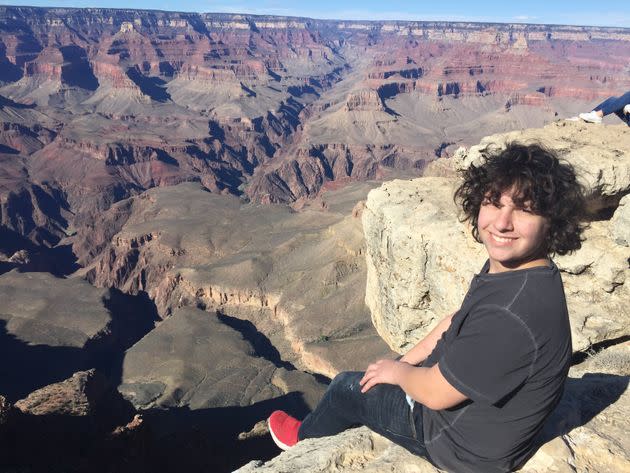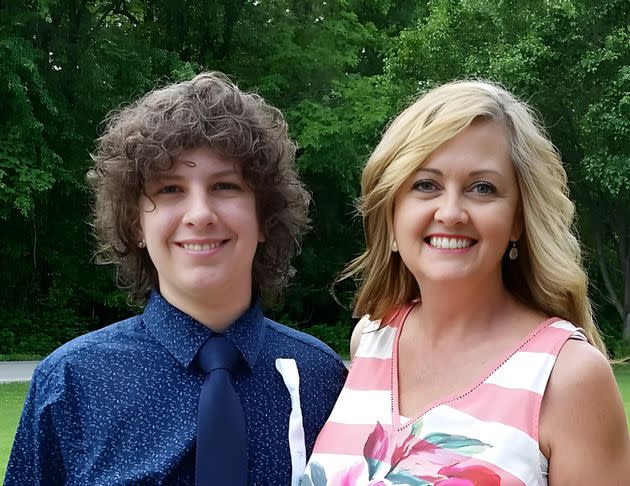A Viral Social Media Trend Killed My Son — And It Could Happen To Your Family, Too

Our youngest of three, Mason, was a typical 15-year-old boy who went to a good school and had great friends. He loved the outdoors, and his favorite pastime was fishing. He loved to entertain us with his witty humor and his amazing cooking skills. He was living a healthy and well-balanced lifestyle. But, in 2019, he died trying a viral social media trend.
On a perfectly routine evening, he went to take a shower. He gave his dad his typical hug and as he walked upstairs, he said, “I love you, Momma.” I replied, “I love you too, buddy.” Those were our last words. A few minutes later, we heard an unusual noise and soon found him with no heartbeat, not breathing, with a belt around his neck.
His dad is a firefighter and immediately started CPR. I’m not sure how he was able to put aside his personal emotions and professionally do what needed to be done. He was heroic and is the reason we were able to extend Mason’s life as much as we could. This gave us time to process what had happened, pray over him while he was on life support for a week, and do what Mason would have wanted — give his lifesaving organs to others.
While my husband was able to get a pulse back with CPR, Mason never woke up. Mason was taken to the hospital where he was pronounced clinically brain dead. He was on life support for three more days while they prepared his body for his organ donation. Our lives have been forever changed, and we miss our son’s generous and caring personality deeply.
During our time grieving his life, we learned that Mason had participated in the viral social media trend called the “choking challenge.” This is a dangerous online stunt where teens temporarily strangle themselves to pass out and then post the recording on social media to get those sought-after laughs and likes that kids crave in today’s digital world. For Mason, the challenge went horribly wrong as the belt locked in place, and he died much too soon.
How could our son, who was such an intelligent boy, end up losing his life to a social media challenge?
Two weeks before his death, he showed me a different challenge on his phone. I spoke with Mason about these harmful social media trends and how to avoid them. I was the mom who monitored my kids’ devices and had all the parental controls turned on. I naively thought we were ahead of the dangers, but social media has a way of finding kids and teens and preying on their vulnerabilities and curious young minds — and Mason was no different.
What worries me most today is that what happened to Mason and our family can happen to anyone — and has happened to others. Families are desperately seeking answers on how to protect their children online. This became clear to me when people from around the world heard about Mason’s story and reached out to me asking how they could protect their children from the harms of social media. I quickly realized that this was not isolated to my family.

I started doing research and partnering with other parents and organizations like Fairplayto spread awareness and learn more about the harms of social media to prevent what happened to my son from happening to any other child. Apps like YouTube, Facebook, Instagram, Snapchat and TikTok use powerful algorithms that are purposefully designed to addict kids and maximize their time spent on each platform. These algorithms mimic the psychological thrill chronic gamblersreceive from playing slot machines. What better way to keep kids hooked than having dangerous trends go viral, creating dopamine rushes and added social pressure to be part of the action? The addiction is real.
Our country has safeguards in place for children and teens to keep them away from adult content such as alcohol, tobacco and legal adult porn. Yet there are no substantial safeguards to protect them from harmful and age-inappropriate content online — which is also extremely addictive. The apps allow kids to be exposed to extortion or “sextortion,” as well as cyberbullying (which often leads to suicide), encourages their participation in dangerous trends, and makes them vulnerable to child sexual exploitation.
I’ve learned how severely lost and helpless we are to the ills of these platforms. Kids and teens are experiencing a mental health epidemic in America. Rates of anxiety and depression are at all-time highs — and as children isolate themselves by retreating into online spaces, feelings of loneliness are only getting worse. Even government officials at the highest levels are starting to see the destructive impact of these platforms, with the U.S. surgeon general recently calling for warning labels to be attached to social media for children. But more needs to be done.
Parents aren’t asking for a free pass from parenting; they are asking for help. We can’t fight the addictive nature of these platforms designed by the biggest industry in America. Parents, teachers and youth are asking for change. If a kid can find a way online (and they will), they will get the dopamine hit the apps deliver.
I have spent the past three years advocating for a federal bill to give parents and young users the tools they need to have a healthy relationship with social media, and we are finally seeing progress. In July, the U.S. Senate thankfully took action on this issue by passing the Kids Online Safety Act (KOSA)in a resounding 91-3 bipartisan vote. I am very hopeful that the House will also pass the bill and it can be signed into law.
KOSA will require social media platforms to have a duty of care with the design of their product like every other American industry. For minors, the platforms would be required to apply robust safety features such as automatically turning on strong safety settings; offering the option to opt out of algorithms, which collect unnecessary personal data used to feed them unsolicited content; and applying more reporting features. Parents would have the option to turn these safety features off, if desired, and minors would still be able to search for content — it simply would no longer be fed to them unsolicited. The bipartisan support we’ve seen with KOSA gives me hope that lawmakers and average citizens alike are seeing the urgent danger presented by Big Tech and are demanding change.
As a mom who has lost a child and is fighting to protect other children, it is difficult to hear some parents say that their children know better. My child was smart. But he was also a boy with a 15-year-old brain. And a young brain isn’t developed enough yet to not be impulsive, to not fall to peer pressure, or to foresee the potential dangers that adults can predict. I pray that every parent realizes their child is considered prey by these companies.
In addition to federal legislation like KOSA, we recently passed a law in Indiana in Mason’s honor giving schools the tools needed to educate students on internet safety. Parents and youth can follow helpful sites like Mason’s Message on Facebook to stay informed about the dangers of social media trends. Beyond legislation, we need dramatic change in the tech industry — the next step is to rebuild the internet and social media apps from the ground up. We can re-architect the foundations of social media to make it impossible for platforms to incorporate addictive features into their design that harm children.
We can’t ban every app or platform, but we can reimagine the digital landscape so everyone has the option of a healthier relationship with their screens. My heart breaks over and over again when I hear children cry out in fear of losing TikTok or any other social media platform. They believe the seeds of misinformation that the platforms are purposefully planting. I believe the People’s Bid for TikTok, led by Project Liberty and founder Frank McCourt, is one of the best and most promising solutions to one of the biggest issues of our day: the toxic digital sphere and its negative impact on kids. Project Liberty’s vision promises to rebuild the app without its current algorithm, creating a safer and better alternative to what exists now.
Moreover, the People’s Bid for TikTok would give people ownership of their data, and put us — not Big Tech’s profit-driven stakeholders — in charge of our digital experience. I’m urging all parents to learn more about this bid and how it would make TikTok safer and healthier for kids — and then to have conversations with their children and other parents about social media and its pervasive harms. A reimagined TikTok would be a major step toward creating a digital world where people are empowered — and kids are protected.
I knew in the beginning that this was not going to be an easy journey, and that I couldn’t do it alone. Nothing will bring my beautiful Mason back, and I miss everything about him every day. I want to live in a way that would make him proud and honor his memory. So each time that I share his story of harm, I hope to save a child. And I will continue to fight for higher standards in our digital world so other families aren’t subjected to the same painful tragedy that mine has gone through.
Our next generation deserves a better online world. And, as parents, we need to stand together and ensure that they receive it.
Do you have a compelling personal story you’d like to see published on HuffPost? Find out what we’re looking for here and send us a pitch at pitch@huffpost.com.

